
© Foteini Christofilopoulou. (Click image for larger version)
English National Ballet
The Sleeping Beauty
★★★★✰
London, Coliseum
6 June 2018
Gallery of pictures by Foteini Christofilopoulou
www.ballet.org.uk
londoncoliseum.org
More than any other ‘classical’ ballet, The Sleeping Beauty requires courtly etiquette. It presupposes a benevolent royal regime whose princess is blessed by supernatural beings, as well as by nobles and peasants alike. Ballet dancers have had to acquire formal politesse in their mime and manners, in addition to polishing their technical prowess. Only contemporary dancers can get away with irreverence, as in Matthew Bourne’s or Mats Ek’s revisions of Beauty.
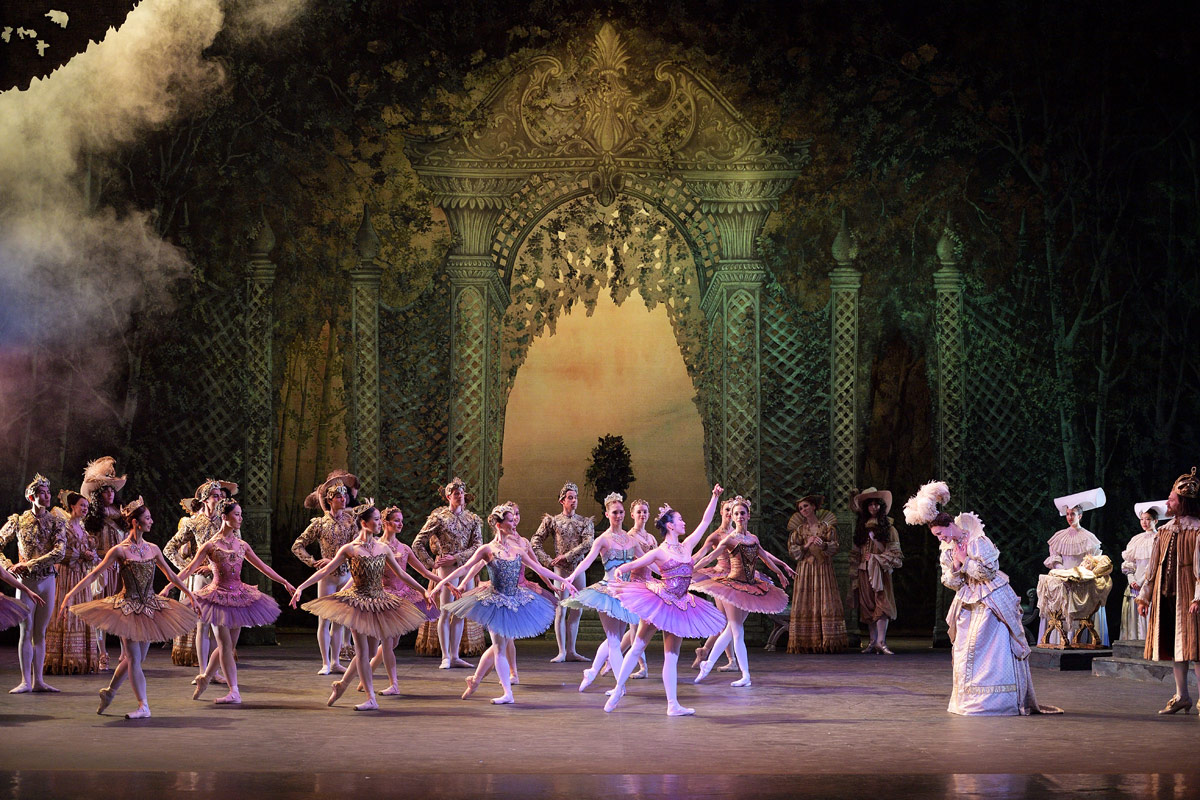
© Laurent Liotardo. (Click image for larger version)
When Kenneth MacMillan mounted his production of The Sleeping Beauty (his third) for American Ballet Theatre in 1986, he wanted to imbue the company with the same respect for tradition as the Royal Ballet. As a young dancer, he had watched De Valois’s 1946 production in the Covent Garden Opera House night after night before performing in it. American Ballet Theatre had no such continuity of experience with Petipa’s choreography, and he felt he had to fight an uphill battle to impose what he wanted.
His production for ABT, with designs by his frequent collaborator Nicholas Georgiadis, lasted for 18 years. ENB acquired it in 2005, with new set designs by Peter Farmer. It’s been five years since the company last performed it, so many of the dancers are new to its demands. However, the first night leading pair, Alina Cojocaru and Joseph Caley, have had plenty of experience in other productions of The Sleeping Beauty (notably the Royal Ballet’s and Birmingham Royal Ballet’s); and Michael Coleman, 78, as Catalabutte is a veteran Master of Ceremonies.
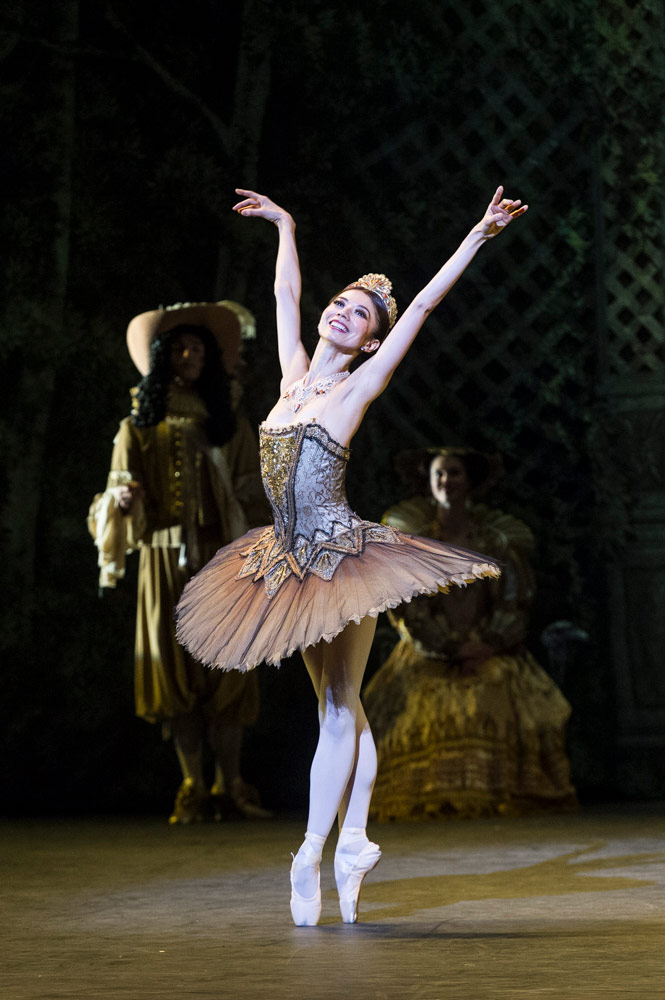
© Foteini Christofilopoulou. (Click image for larger version)
The company as a whole knows how to comport themselves in Georgiadis’s sumptuous costumes, in a much lighter palette than usual for him of cream and gold. The hundred-year gap moves from the 17th century, with finery based on Van Dyke paintings, to the 18th, inspired by Tiepolo’s fantasies. The corps and soloists represent a harmonious social order threatened by a malicious curse. Quite where Carabosse, resembling a ravaged Elizabeth I, fits into either period is a magical mystery, as are the ravishing tutus.
Peter Farmer sets the fairy tale in verdant spring for Aurora’s christening and coming-of-age, then in winter for the Prince’s hunt. Wedding celebrations take place in a filigree palace, as promised by the entry gates in Act I. A touring production cannot, alas, accommodate a convincing forest or an entrancing panorama for the Prince’s journey to find Aurora.
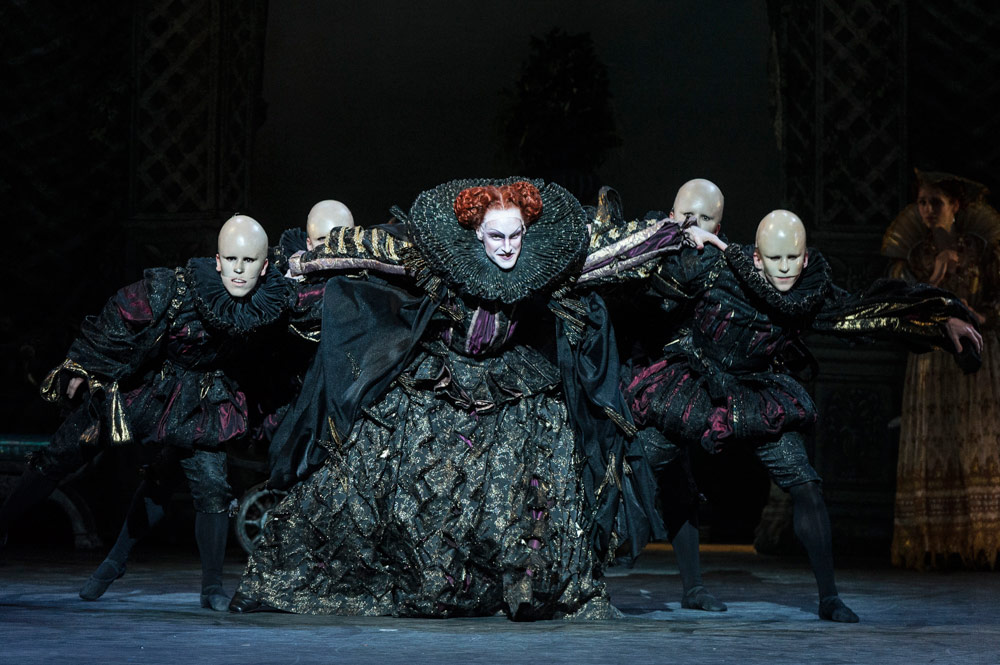
© Foteini Christofilopoulou. (Click image for larger version)
MacMillan’s staging places significant tableaux centre stage, the focus of all attention. Baby Aurora is brought forward by her two nurses to be blessed by the Lilac Fairy on high, surrounded by her fairy godmothers. I could wish, though, that the fairies were more aware of the infant in their solos, presenting her with gifts of character rather than waving their arms around prettily. James Streeter’s outraged Carabosse mocks them viciously, telling them to get lost as a waste of effort.
His mime is graphic, luring the King and Queen into believing their daughter would grow up beautifully until delivering the punch line of poison by spindle. Shiori Kase’s Lilac graciously commutes the death sentence into a protracted coma, promising that all would be well by the end of Act II. Warm and womanly, secure in her dancing as in her mime, Kase is too small to dominate her entourage, let alone fearsome Carabosse. She can’t draw the eye, as Alina Cojocaru can as Aurora.
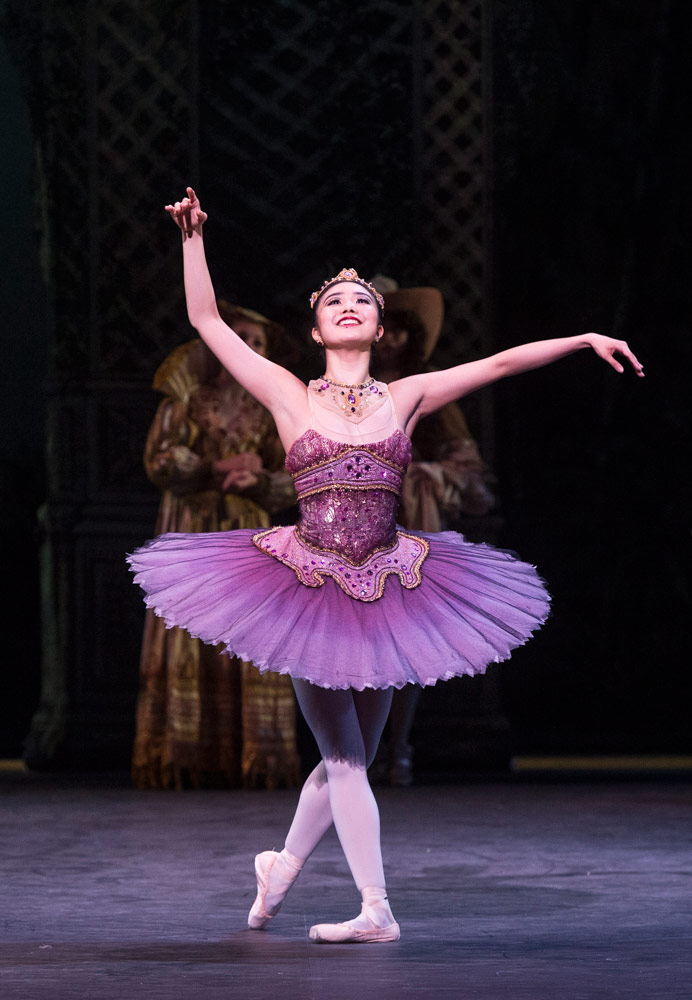
© Foteini Christofilopoulou. (Click image for larger version)
MacMillan builds the excitement for her entry in Act I. He sets up the trio of knitting women as harbingers of danger, giving them due prominence. They and the ‘townspeople’, according to the synopsis (evidently not peasants) perform his choreography. The Garland dancers are hampered by large stiff floral arcs, congesting the corps into formation mincing on an overcrowded stage. They shed their hoops and return to cluster with the courtiers in anticipation of Aurora’s arrival.
Cojocaru, glowing with delight, is every tiny inch the privileged princess, adored by her parents and admired by their subjects. ‘Here I am’, she announces, arms held triumphantly above her head en couronne, filling the proscenium space. She gives the impression of skimming the stage in jumps and turns, almost dizzy with pleasure at her birthday party. This is the high point of Aurora’s young life so far. She greets each suitor with confident interest, rather than wondering whether he will like her – and she’s in no need of reassurance from her parents. Cojocaru takes the Cecchetti line in attitude for the series of balances rather than the Russian one with the foot higher than the knee. (It’s best not to look at her feet too closely.) She didn’t prolong the tension into a circus act on the opening night, preferring not to distort the music’s tempi.

© Foteini Christofilopoulou. (Click image for larger version)
Now 37 and a recent mother, Cojocaru can still seem a 16-year-old Aurora, shocked at her first experience of pain when she pricks her finger on Carabosse’s spindle. As ever, the suitors, friends and courtiers are no use in a crisis, failing to thwart the wicked fairy’s curse. They all depart, leaving the Lilac Fairy with scarcely a soul to put to sleep as the curtain closes.
The 18th century hunt at the start of Act II is a sombre affair, with most of the participants in black. Is the Prince in mourning? No wonder he looks sad, though he twice denies it. Caley cuts a commanding figure, despite his boyish looks. His soliloquy in MacMillan’s choreography is less taxing than the ones inspired (or created) by Nureyev. The vision scene is not about the Prince, after all. It’s to show off Aurora and her protective nymphs, giving her the chance to be imagined as an idealised, elusive woman. Cojocaru, as insubstantial as a dream, owns the stage, the wistful line of her neck complementing the curves of her arms.
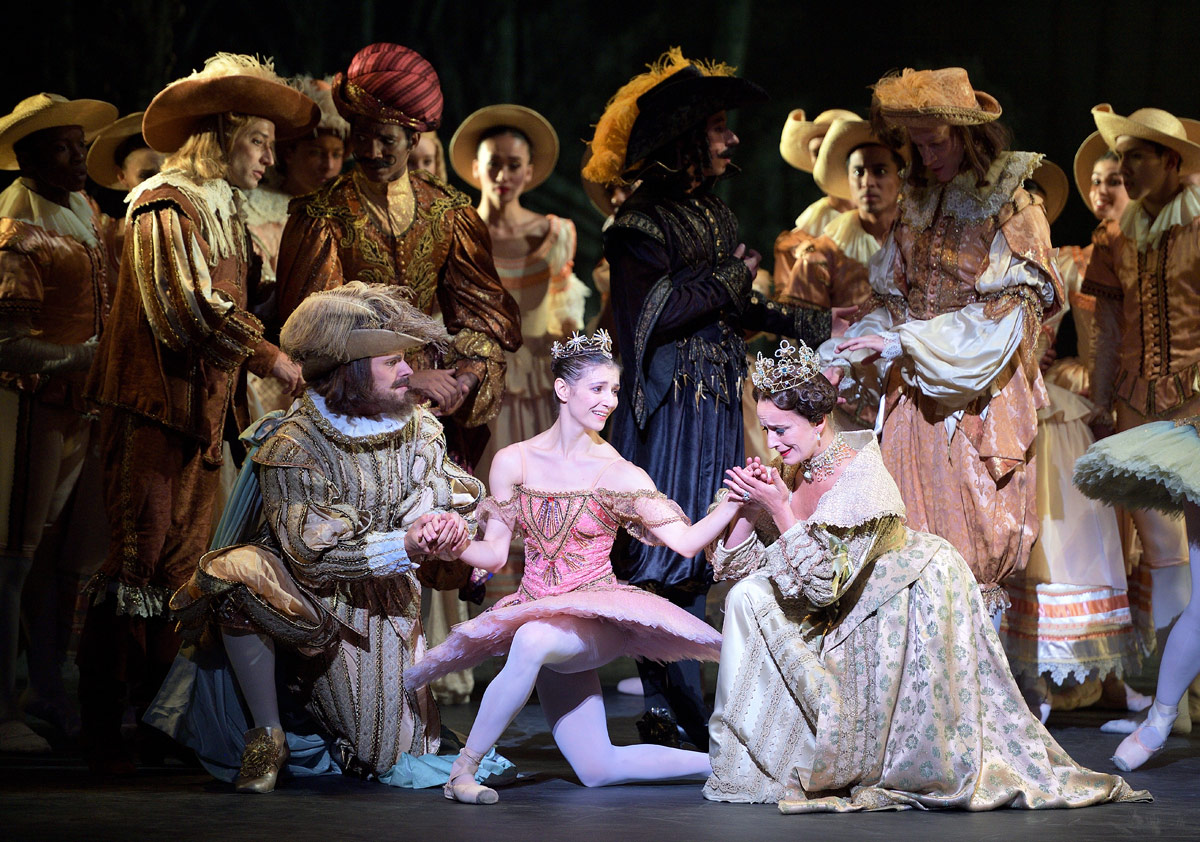
© Laurent Liotardo. (Click image for larger version)
Aurora’s solo, with each leg in turn describing an enveloppé descent, resembles that by Ashton for the Royal Ballet. MacMillan defended his choreography for the solo by stating that he drew on the same source as Ashton: descriptions of the one Petipa devised for Carlotta Brianza in 1890, to music originally intended for the Gold Fairy in Act III. Cojocaru dances it as an airy commentary on the changing rhythms of Tchaikovsky’s féerie fantasy.
The Awakening scene is well-staged, with Carabosse very much present, defying the Lilac Fairy until her power is dissolved by the Prince’s kiss. The production segues swiftly into the wedding celebrations of Act III, led by courtiers and fairy tale characters in a Polonaise. I spotted Chase Johnsey, former Trockadero member and now a First Artist with ENB, among the female dancers, smiling happily beneath one of Georgiadis’s flamboyant hats.

© Foteini Christofilopoulou. (Click image for larger version)
MacMillan’s choreography includes a solo for the male Jewel Fairy (Ken Saruhashi) and rearrangements for the four female ones, mostly unremarkable. The Pussy Cats and Bluebirds pleased the audience more, with Rina Kanehara outstanding as Princess Florine, as she had been as the fifth of the Prologue fairies. Daniel McCormick as the Bluebird has plenty of promise but needs to fit in yet more beaten steps. There is time, just, for Red Riding Hood (Jennie Harrington) to tantalise the Wolf (Shevelle Dynott) but not for any more fairy tale numbers before the Grand Pas de Deux for Aurora and her Prince.

© Foteini Christofilopoulou. (Click image for larger version)
Cojocaru and Caley looked as though they were thoroughly enjoying themselves, while executing the formalities of the union of their two royal estates. They part to pace out their boundaries, then come together for an ecstatic kiss. Caley, who is no Nureyev, is modest and attentive; Cojocaru has the serene grandeur of a ballerina, so much more than the charming ingenue of Act I. She brings the 19th century ballet very much alive, boosted by the enthusiastic playing of Tchaikovsky’s score by ENB’s Philharmonic orchestra, conducted by Gavin Sutherland. It’s a better Sleeping Beauty than the Royal Ballet’s, but it benefits enormously from a stellar performance at its heart, a reminder of how civilised ballet can be.













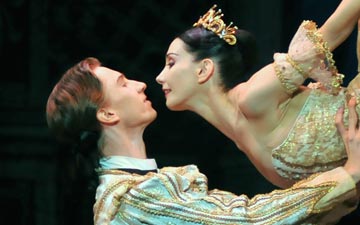
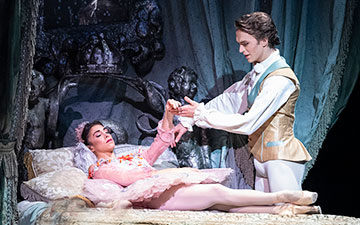

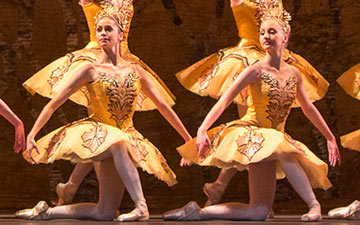
You must be logged in to post a comment.